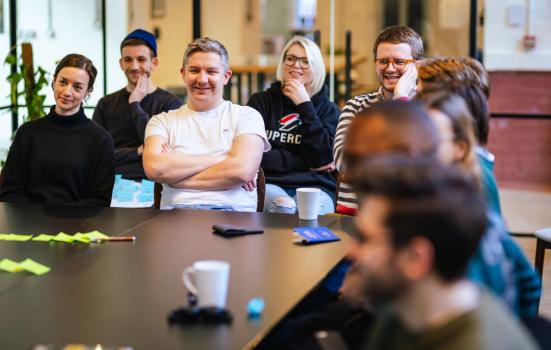In the competitive field of fundraising, digital gift giving has been experiencing a boom, as Stephanie Clark explains.

"Charities need to spend time examining how the fundraising landscape has changed and how the rise of digital fundraising will affect them." (CAF Charity Landscape 2022)
The rise in digital literacy is often cited as one of the few positives from the Covid pandemic. As arts and cultural organisations were fighting for survival, many were able to rapidly shift their programming and outreach work online. Some with unprecedented success.
According to the Charities Aid Foundation report, digital fundraising also came to the fore during Covid with approximately 30% of individual gifts in the UK being made online in 2020. This was a sharp increase from 20% the previous year. And while this was expected to decrease coming out of the pandemic, 2021 was still significantly higher than 2019 with 26% of individual gifts being made online.
But despite learnings from Covid and the recognised importance of digital fundraising, many leaders admit not having the knowledge to effectively raise funds online.
"In an increasingly digital landscape, only a quarter of charity leaders know how to make their online fundraising truly effective."(CAF Charity Landscape 2022)
According to a Blackbaud report, when asked to evaluate digital maturity in 2021, only 12% of charitable organisations in the UK scored themselves highly. Reassuringly, this figure rose to 18% in 2022, but while progress is being made, there’s still some way to go.
At Substrakt, we encourage arts and cultural organisations to prioritise digital because, when approached correctly, we know how it can advance an organisation. Audience development, programme delivery, Equity Diversity and Inclusion (EDI) and income generation strategies all benefit when digital is a core component.
So, if you’re thinking about improving digital fundraising at your organisation, we’ve created a checklist for optimising two key stages of the online giving journey: email and website.
The art of the email
Email strategy and optimisation is something of an art form and fundraisers must take inspiration from digital marketing if they are to maximise success. There are lots of resources to help craft email content and improve performance, but here are a few crucial questions to consider when creating email campaigns.
● Who is receiving the email?
Personal salutations will increase affinity with your organisation.
● How do you decide what is sent to whom?
Segmenting your audience will help you to keep your content relevant for the recipient and reduce the likelihood of unsubscribes.
● Who is sending the email?
Recipients are far more likely to open emails from individuals rather than organisations.
● Is the subject line considered?
Your email must grab attention when sitting in an inbox full of 'unreads’. Aim to entice.
● What is the purpose of the email?
Each email must have a clear focus and call to action – not necessarily about making a gift. You may just want to encourage further engagement such as viewing another piece of content.
● How are you measuring success of the campaign?
Unlike other forms of communication such as direct mail, there’s a wealth of data available to help you analyse how recipients are responding. Work with your marketing team to track key analytics to better understand the effectiveness of your campaign using metrics like open rate, click throughs and conversions.
Showcasing your website
Your website is a unique opportunity to showcase how philanthropy can make a difference to your organisation. It’s also a powerful tool for cultivating and converting prospects at home and further afield, as demonstrated during the pandemic. When reviewing your website, you must consider:
● Are your pages up to date?
Incorrect information creates doubt for users. Content must not be created and then forgotten about: it must be maintained. Regularly review pages to ensure accuracy of information and care for content.
.
● Are you effectively demonstrating impact?
We often find impressive details about an organisation's achievements hidden away in downloadable PDFs. If you’re investing time and energy into creating these resources, ensure they’re visible and stop relying on your annual report.
● Is your copy appropriate for digital consumption?
Reading behaviour online does not match that offline. When creating web copy, be mindful of how users digest information and aim to continuously improve web writing.
● Is anyone coming to the website?
If you’re not actively directing users to your website, your pages are likely to be getting very little traffic and you’re missing new online prospects. Review analytics data for a visitor baseline and then develop strategies for increasing engagement via email or social media campaigns.
"1 in 8 are considering cutting back on donations to charity to help them manage their bills." (CAF UK Giving Report 2022)
With the after effects of the pandemic and the cost-of-living crisis, the current landscape is particularly difficult. Fundraising teams are increasingly under-resourced and overstretched. So it makes sense to maximise giving channels and optimise ‘low effort’ income streams like online giving.
Digital is cheap, quick to execute and, when prioritised, can have a significant impact on fundraising capability. To find out about how to run successful digital fundraising campaigns, register for Substrakt’s upcoming webinar on Thursday 11 May.
Stephanie Clark is Head of Strategy and Consulting at Substrakt.
![]() substrakt.com
substrakt.com
![]() @substrakt
@substrakt
This article is part of a series contributed by Substrakt exploring the many ways in which arts and cultural organisations can embrace the world of digital.





